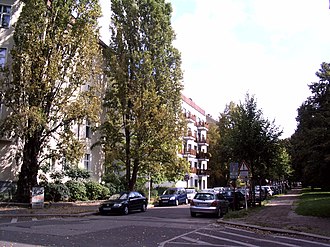Tyrolean quarter
The Tiroler Viertel is a Berlin residential area in the Berlin-Pankow district .
history
It is located in the southwest of Pankow directly adjacent to the Prenzlauer Berg district . The name is derived from the streets and squares that were given names with reference to the Austrian province of Tyrol when they were opened at the beginning of the 20th century . The almost 37 hectare, triangular residential area is bounded in the north-west by the tracks of the Szczecin Railway , in the north-east by Mühlenstrasse ( B 96a ) and in the south by the Esplanade street . The city center can be reached quickly via the Vinetastraße underground station on the eastern edge.
In 1905, the "Deutsche Bodengesellschaft mbH" acquired the area and in the following years laid out a road network that was supposed to enable modern development of the residential development. Since the systematic start of construction was delayed several times and this was promoted by urban development, the allotment gardens that were laid out in some places, which were mainly laid out in the 19th century by the population of the then North Berlin district of Prenzlauer Berg, have remained. In the 1920s houses were built by several settlement cooperatives; today these are mainly owned by the city company Gesobau . The economic crisis and the Second World War prevented complete development, which was only carried out from the end of the 1950s by the predecessor cooperative of today's “ First Housing Cooperative Berlin-Pankow ”.
After 1990, some high-quality new buildings were inserted in vacant lots. Overall, the quarter is now a solid mix of old and new with relatively low tenant fluctuation. A "blot" that had been neglected for decades, the Klecks elementary school, which was built using prefabricated panels, was completely renovated in 2005. The area is crowned by Andreas-Hofer-Platz, a 150 by 180 meter park with a hill of rubble, called “Brenner” or “Brennerberg” by the residents, which in winter regularly turns into a toboggan hill for children with slopes different demands. The construction boom in the Pankow district ( Garbáty , Alte Mälzerei , Gaillardstrasse, Brehmestrasse, Florastrasse), which has been recorded since 2011, can also be felt in the Tyrolean quarter. In 2009, another gap in the building on Brennerstrasse, torn by American bombs in May 1944, was closed. In the following years, war gaps were or will be built on in Tiroler Strasse and Brennerstrasse .
Architectural monuments
- Residential complex Dolomitenstrasse 15–39, built 1929–1930, architect “Zeller”
- Residential complex Maximilianstrasse 16–25, 1928–1932, architect Willy Brede (together with buildings at Brixener Strasse 55–69 and Dolomitenstrasse 44–68)
- Housing complex Brenner Strasse 18–48, built 1928–1929, architect “Zeller” (together with buildings at Brixener Strasse 21–23 and Trienter Strasse 6–8)
- Housing complex Zillertalstrasse 1–27, built in 1930, architect Adolf Siegmann (together with buildings at Brixener Strasse 45 and Trienter Strasse 26)
traffic
Schöneberg
- In 1910, when it was still independent, a “Tyrolean quarter” was started north of Innsbrucker Platz in Schöneberg . Due to the First World War and the inflation and the transfer of planning to the authorities of Greater Berlin , it was not closed in terms of urban planning and can only be recognized by a few street names. Accordingly, it is not named as such.
Web links
Individual evidence
- ↑ Berlin-Schöneberg - B. Directory of the streets with all the houses ... In: Berliner Adreßbuch , 1914, V., p. 304 (also: # 6075, p. 293: street plan).
Coordinates: 52 ° 33 ′ 36 ″ N , 13 ° 24 ′ 26 ″ E
